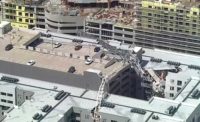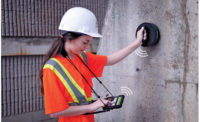A tower crane being dismantled collapsed Saturday, April 27 in Seattle, killing four people, including two ironworkers on the crane and two bystanders on the street below. The jobsite, located in a Google office development in Seattle's bustling South Lake Union neighborhood, is adjacent to a busy intersection where traffic had not been blocked off during the crane’s disassembly. It is the first fatal crane accident in the Puget Sound region since a crane collapse in Bellevue, Wash., in 2006 that killed one person.
At the time of the collapse the Liebherr tower crane had already been partially dismantled, with the jib, counterweight and counter-jib removed. Crews were preparing to take down the crane’s slewing ring with the cab still attached using a nearby luffing-jib mobile crane, when the tower crane’s mast fell across the building, depositing the slewing ring and a double-segment of the mast onto an active roadway.
The two ironworkers killed on the site were identified by the Ironworkers union as Travis Corbet, 33, of Local 29 in Oregon and Andrew Yoder, 31, of Local 86 in Washington. Sarah Wong, 19, a student at Seattle Pacific University, and Alan Justad, 71, former deputy director of Seattle’s Dept. of Planning and Development, were also killed.
The Washington State Dept. of Labor & Industries (L&I) has opened an investigation into the collapse, and is looking into the companies involved. The crane, owned by Salem, Ore.-based Morrow Equipment Co., was being dismantled by ironworkers from Northwest Tower Crane Service Inc., based in Des Moines, Wash. They were working as a subcontractor to Bellevue, Wash.-based general contractor GLY Construction. The luffing crane assisting in the disassembly was operated by Omega Morgan, based in Hillsboro, Ore. L&I is also investigating Seaburg Construction Corp., based in Woodinville, Wash., which employed the tower crane operator who would have been present during the dismantling of the jib and counter-jib.
L&I has concluded its on-site investigation as of April 30, a spokesperson told ENR. “We ‘red-tagged’ the tower crane involved, and investigators have been on site, taking photographs and measurements, looking at pieces as they are removed,” says Tim Church, L&I public affairs manager. Under Wash. state law, tower cranes must be regularly certified if they are to be used in construction, and according to Church, L&I records show the crane that collapsed had last been certified by a third-party certifier on June 30, 2018. While all five companies have been previously investigated by L&I on other occasions, Church says the inspections had been mostly clean with no major violations that stood out in an initial review, though further investigations are still under way.
In a press statement following the crane collapse, general contractor GLY Construction said that it was “deeply saddened and heartbroken by what happened at our jobsite” and that it is fully cooperating with investigators and local authorities.
“Our hearts and prayers go out to our fellow brothers as well as the pedestrians injured and killed,” Ironworkers International president Eric Dean told ENR. According to Dean, ironworkers Corbet and Yoder had ten and eight years of experience respectively, and had both been working with Northwest Tower Crane Service for several years. “The Ironworkers strive to send their workers to work and home safely every day, and to raise the consciousness of our members to reduce injuries and jobsite fatalities,” Dean says.
Crane Experts See Possible Explanation in Loosened Pins
While there have been no initial conclusions released by L&I investigators, crane safety experts from across the industry have told ENR that they suspect that crews on the site may have prematurely loosened or removed the pins that secured the slew ring to the tower and the tower mast sections to each other, in order to save time. This procedure is not recommended or condoned by the crane manufacturer’s manuals, but several crane safety specialists tell ENR it has become a fairly common practice in recent years in order to speed disassembly of the crane and reduce the number of workers needed on the mast to complete the process.
“No manufacturer designs a crane to fail,” says Greg Teslia, president of Crane Safety & Inspections. “That's why they have manuals to go with the crane with the proper procedures to follow.” An experienced tower crane operator and inspector, Teslia says that the visible separation of the slew ring from the tower and the tower sections from each other during the collapse suggest to him that pins securing them together had been loosened or removed ahead of time. “[I think] the erectors unpinned the turntable to first section, then to the next double [mast section], and that's what we see in the final resting position, a lot of double sections laying across the building and the ground,” he says. According to Teslia and other crane experts ENR spoke to, crane mast sections are often removed and stored in double sections because they are a length easy to transport on a trailer.
The section connections in the Liebherr crane mast consist of 18-in.-long metal sleeves on each corner that thread into holes on the adjacent section. These are secured with metal pins that are torqued to maintain strength. There are two pins at each corner, for a total of eight pins per segment connection. Crane manufacturers generally stipulate that during disassembly the pins should only be de-torqued and removed on a connection when a supporting crane is ready to pick the next section off. But some crane experts, including Teslia, say crews over the years have begun de-torquing many pins in advance to save time and reduce the number of workers needed to stay on the mast.
“You would think the weight of the tower would keep it in place, with those 18-in. pieces that run into the connecting sections,” says Teslia. “You can get away with unpinning the turntable and the first-to-second section [of the tower mast], but overall it adds up when you look at the entire wind surface of the tower. If they disconnected all the way to the base or close to it, that is where this [failure] likely started.”
A Flashback to Dallas
While the real cause of the collapse is still unconfirmed, the failure of the tower crane mast in Seattle drew comparisons from several crane experts contacted by ENR to a similar crane mast failure in Dallas, Texas, in 2012. In that case, a Terex Peiner crane mast was being dismantled, when a strong wind caused it to topple over and collapse. The crane sections in that instance were connected with bolts between flat surfaces instead of pins in metal sleeves, but there were some similarities to the Seattle collapse. Experts at the time pointed to the lack of damage at the connection points, indicating the bolts had been removed ahead of time.
Terry McGettigan, a Seattle-based tower crane specialist, said he was still considering the specific circumstances of the Seattle crane collapse, but did refer ENR to an article he had written following the Dallas collapse, saying it was highly relevant to the current investigation. At the time, McGettigan wrote, “I have been warning about risky practices such as mast bolt de-torque and other shortcuts for years; and how many companies—little by little over the years—have strayed from manufacturers' instructions and regulatory rules.” In the case of the Dallas collapse, McGettigan said that the strong wind was only a contributing factor and the mast would not have blown over if all of the bolts had stayed torqued.
|
Update 5/2/19: |
Too Soon for Final Answers
Officially the cause of the Seattle crane collapse is still unknown. Lift plans are required for operations such as crane disassembly, with sign offs from team members including crane operators and technicians, but L&I has not made those documents available to the public. Weather services did not report strong winds at the time, and while the luffing-jib crane assisting in the disassembly did have a wind speed anemometer on the jib, it is unclear if the data was being recorded. For now, crane industry experts can only speculate about causes based on publicly available photo and video evidence.
By state law, L&I has six months to complete its investigation into the incident, and L&I's Church says the regulator will probably take most of that time to complete its work. “There’s a lot of speculation out there right now, and we’re doing our best not to address each theory,” he told ENR. “It’s a thorough, painstaking process as we look at everything involved.”






Post a comment to this article
Report Abusive Comment